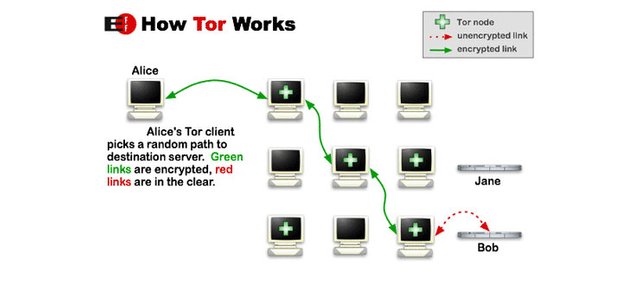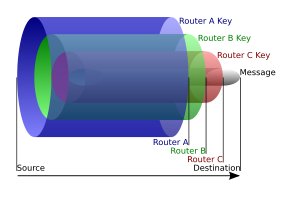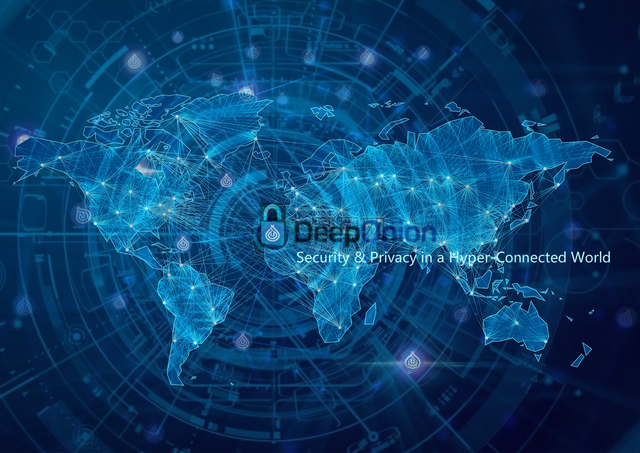The Almighty Tor, Onion protocol and DeepWeb in the use of DeepOnion

Given the fact that our privacy is something most valuable to us these days, why our transactions aren't private? Why do we need to uncover all of our info to make transactions? Well, DeepOnion has decided to devote its work to enhancing privacy, and the primary goal of the project is to provide you anonymous and untraceable transactions. Your right as is to have a choice whether you want to reveal your information or not and DeepOnion gives you that choice. But in which way this can be possible, you might wonder. Well, the first thing you probably heard about the DeepOnion is that it is a privacy coin that has native Tor integration. You must have heard of it, at least you ran into something named DeepWeb. Let's break all of this into small pieces and describe how this particular network makes preservation of your privacy possible.
What is Tor?
I have written a bit about this particular subject in my article Why Obfs4 Is Important For Cryptocurrencies, but the purpose of this writing was to give you an overall info in order to understand the need for obfuscation, but you can read about it after you understand what Tor is, how it operates and some terms related to it. So let's take a look at the info available on Tor's official page:
'”The Tor network is a group of volunteer-operated servers that allow people to improve their privacy and security on the Internet. Tor's users employ this network by connecting through a series of virtual tunnels rather than making a direct connection, thus allowing both organizations and individuals to share information over public networks without compromising their privacy.”
Tor is a tool available for everyone who wants to protect his privacy. Traffic analysis makes your data visible to your Internet provider, your browser, etc. Companies who track this use the acquired data to find out more about you. The Tor network makes possible for you to reach to blocked content, hide your content from others, but share it with a particular person, reach out to the websites in the countries in which your IP is banned, etc. The journalists use it, software developers to make more privacy-related features, people that want to use instant messaging without any interference, as well as the non-governmental organizations. The main benefit of Tor is that it has so many users, which serve each other for protection. How is this done?

Tor is used to make private network pathway, meaning that it creates a different path from the one that can be directly connected to your data and your destination data. Instead of sending your transaction using the expected, direct pathway, the software creates a circuit through relays on the network, which needs to be encrypted in order not to be tracked. The circuit is designed to make one hop at the time, which has individual encryption key (to prevent tracing), presenting only the information from which relay it comes and to which relay is heading, making impossible to track the whole path. One relay – one user. Figure the math.
What is Onion protocol?
“In an onion network, messages are encapsulated in layers of encryption, analogous to layers of an onion. The encrypted data is transmitted through a series of network nodes called onion routers, each of which "peels" from a single layer, uncovering the data's next destination. When the final layer is decrypted, the message arrives at its destination. The sender remains anonymous because each intermediary knows only the location of the immediately preceding and following nodes.” - Wikipedia

Тоr uses Onion services to enable layered and encrypted transmission of data. This is provided by Onion protocol. This should be not confused with the Tor network itself since it is a way of routing, not a network, but a protocol which enables the network. Garlic routing, on the other hand (yes, another onion, but more complicated one) is a more advanced type of routing which provides multiple encryptions to protect your data and make your transaction faster. The reason why we need obfuscation is an exit node, where the data which has been encrypted needs to get decrypted. But no worries, DeepOnion has covered that with the latest OBSF4 upgrade which I have mentioned earlier.
What is DeepWeb?
DeepWeb is a network that contains web pages and content that browsers can't track. DeepWeb contains webmail pages, forums with specific types of applying, bank information and other user databases. To describe how big is DeepWeb, let's just say that for one page on regular Web, there is at least one page on the DeepWeb as well that browsers don't index. To put it simply – anything that requires a password and it is hidden from regular browsers, it is located on the DeepWeb. DeepWeb uses Tor network, and it contains all the info that needs for some reason to be kept and private. This doesn't necessarily include any terrible things. You can access some pages without revealing your personal info, and that's fine. That is your right.
What is the difference between DeepWeb and DarkWeb?
DarkWeb is a small part of DeepWeb since it is not indexed anywhere. There is a big difference between these two. DarkWeb is a collection of sites with specific content, mostly illegal or dangerous. “Silk Road” is a famous collection of sites for drug dealing. So – do NOT MIX these two! DeepWeb is used to protect your data from abuse, so it is created to help you keep your privacy. DarkWeb has a totally different purpose.
What all of this has to do with DeepOnion?
DeepOnion's name is not put like that accidentally. The name comes from two words: “Deep” because it operates through DeepWeb to protect you data and make it untraceable, and “Onion” because of Onion protocol that makes it possible. The purpose of using Tor is to protect your data and make your transactions untraceable. Don't let people fool you by telling nasty stuff about Tor and DeepWeb. I hope that this article will clear some things up. The Tor integration is important, mainly because it is native integration. This project is still growing and adapting. The important thing is that the team is listening and always searching for possible adjustments. DeepOnion has a noble goal – to protect your fundamental human right to privacy and give you the possibility to choose whether you want to reveal your data or not.

Additional anonymity assets and features
If you are interested in features which purpose is to take your privacy to another level, you can go through some of my articles and articles that are written by some of our respected members:
DeepSend: https://deeponion.org/community/threads/article-why-is-deepsend-going-to-be-a-revolutionary-feature-of-deeponion.31162/
Obsf4: https://deeponion.org/community/threads/article-why-obfs4-is-important-for-cryptocurrencies.28327/#post-471722
Stealth Address: https://deeponion.org/community/threads/article-more-onions-in-airdrop-and-stealth-address-upcoming.30009/
Read more about the coin here: https://deeponion.org/White-Paper.pdf
Our official site: https://deeponion.org
I hope I have managed to help you in some way. Any feedback is welcome.
Cheers!
Congratulations @nevenam! You have completed some achievement on Steemit and have been rewarded with new badge(s) :
Click on any badge to view your own Board of Honor on SteemitBoard.
For more information about SteemitBoard, click here
If you no longer want to receive notifications, reply to this comment with the word
STOPCongratulations @nevenam! You received a personal award!
Click here to view your Board
Congratulations @nevenam! You received a personal award!
You can view your badges on your Steem Board and compare to others on the Steem Ranking
Vote for @Steemitboard as a witness to get one more award and increased upvotes!